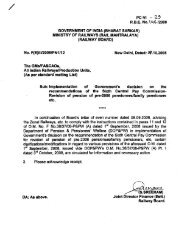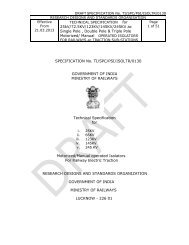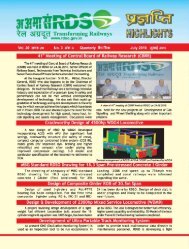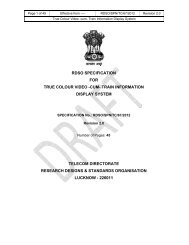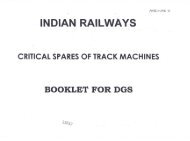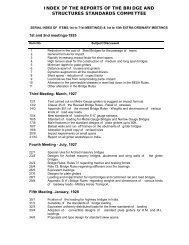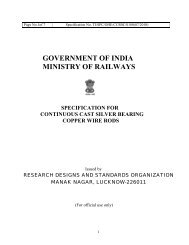ASSESSMENT OF RESIDUAL LIFE OF GIRDERS OF BRIDGE No
ASSESSMENT OF RESIDUAL LIFE OF GIRDERS OF BRIDGE No
ASSESSMENT OF RESIDUAL LIFE OF GIRDERS OF BRIDGE No
You also want an ePaper? Increase the reach of your titles
YUMPU automatically turns print PDFs into web optimized ePapers that Google loves.
Ministry of Railways<br />
Government of India<br />
<strong>ASSESSMENT</strong> <strong>OF</strong> <strong>RESIDUAL</strong> <strong>LIFE</strong> <strong>OF</strong> <strong>GIRDERS</strong> <strong>OF</strong> <strong>BRIDGE</strong><br />
NO. 73 & 75 (ABANDONED), VASAI CREEK <strong>BRIDGE</strong>S ON<br />
BORIVALI – VIRAR SECTION <strong>OF</strong> WESTERN RAILWAY<br />
REPORT NO. BS –79<br />
MAY 2006<br />
RESEARCH DESIGNS AND STANDARDS ORGANISATION<br />
MANAK NAGAR LUCKNOW-226011<br />
1
PREFACE<br />
Whenever, a bridge is abandoned due to its weak substructure or some<br />
other reasons before completing its codal life, it is important to know the residual<br />
fatigue life of girders of its superstructure. If substantial life is still left, these<br />
girders can be used on other routes. If the traffic density of such routes are<br />
lower, these girders can be used for much more life span. Bridge <strong>No</strong>. 73 & 75,<br />
known as Vasai creek bridges of Mumbai Central–Virar section of Mumbai<br />
Division of W. Railway were abandoned due to their weak substructures after<br />
completing about 66 years of service life and may have still, some useful life.<br />
For estimation of the residual fatigue life of the girders by using S.N. curve<br />
Approach, apart from the of stress- cycles (S.N.) curve of the material, the<br />
stress-time history for the present day traffic passing over the girders is<br />
essential, which is not possible to be obtained in case of above bridges, as the<br />
bridges have been abandoned primarily due to weak sub–structure. For such<br />
situation, the provisions of para. 9.2&9.3 of BS code 5400 part-10 are used for<br />
assessment of residual fatigue life of these bridges. However, for more realistic<br />
results, S.N. curve has been developed by fatigue testing of some samples<br />
taken out from the existing girders. The S.N. curve, so developed, has been<br />
used for assessing the residual life of the girders, by the method using damage<br />
calculation.<br />
For this work, a test team of S/Shri Ramji lal, SRE and S.K. Awasthi,<br />
JRE-1 under the guidance of Sh. S.C.Gupta, Director/B&S/Testing was<br />
constituted. The assessment of the residual fatigue life of the girders is done by<br />
this team.<br />
Fatigue testing of the samples was conducted by the staff of Fatigue<br />
Testing Lab., under the guidance of Shri Mohan lal, SRE.<br />
Contribution of all the team members in assessment of residual life<br />
of the girders is highly appreciated. Guidance provided by Shri S.C. Gupta, to<br />
the team members was worth appreciating, and sincerely acknowledged.<br />
This report is submitted herewith for further necessary action to Executive<br />
Director ( Works), Railway Board, New Delhi.<br />
2<br />
( LALLOO SINGH )<br />
Executive Director/ B&S
INDEX<br />
S.<strong>No</strong> Contents Page no.<br />
1. Introduction 1<br />
2. Objective 1<br />
3. History of the bridge 1<br />
4. Methodology 2<br />
5. Estimation of residual fatigue life 7<br />
6 observations 10<br />
7. Conclusions<br />
TABLES<br />
11<br />
1 RU Loading: Annual traffic tonnage for standard traffic<br />
types<br />
12<br />
2 Details of fatigue testing of specimen taken out from<br />
girders of existing abandoned bridge<br />
13<br />
3 Details of past traffic passed ( GMT ) between BCT-VR<br />
14<br />
section<br />
1<br />
FIGURES<br />
Test specimen for fatigue testing 15<br />
2 S-N Curve 16<br />
3 Bar chart of traffic density between BCT-VR section during<br />
1950-96<br />
17<br />
3a Cumulative Increase in traffic density since 1950-96 17<br />
4 Histogram of computed stress cycles with different stress<br />
ranges for light traffic and traffic density of 27 GMT<br />
18<br />
5 Graph of residual life and traffic density 18<br />
ANNEXURES<br />
I Copy of the letter from Exe. Director ( Works ) Rly. Board<br />
for assessment of Residual life of Bridge <strong>No</strong>. 73<br />
( Abandoned ) near Mumbai<br />
II Calculation sheet for maximum stress range 24<br />
III References 26<br />
<strong>ASSESSMENT</strong> <strong>OF</strong> <strong>RESIDUAL</strong> <strong>LIFE</strong> <strong>OF</strong> <strong>GIRDERS</strong> <strong>OF</strong> <strong>BRIDGE</strong> NO. 73 & 75<br />
(ABANDONED), VASAI CREEK <strong>BRIDGE</strong>S ON BORIVALI – VIRAR SECTION<br />
<strong>OF</strong> WESTERN RAILWAY<br />
3<br />
19
1.0 INTRODUCTION:-<br />
Vide Executive Director ( Works) , Railway Board’s DO <strong>No</strong>. 2004/WI /WR/<br />
Girder dt. 30.04.04, Member Engineering desired that a study may be<br />
conducted to assess the residual life of the girders of the bridge <strong>No</strong>. 73 &<br />
75 (Abandoned). With a view to use them on new branch line where the<br />
traffic is going to be light in the beginning. The copy of the above letter<br />
alongwith a report prepared by Western Railway on this issue is placed at<br />
Annexure – I.<br />
2.0 OBJECTIVE:-<br />
To assess the residual life of the girders of bridge <strong>No</strong>. 73 & 75 Mumbai<br />
division of W.R.<br />
3.0 HISTORY <strong>OF</strong> THE <strong>BRIDGE</strong>S:-<br />
The bridge <strong>No</strong>. 73 & 75 (abandoned) are located on Basai Creek between<br />
Bhainder and Naigaon stations of Borivali – Virar suburban sections of<br />
Western Railway. The abandoned bridges were open to traffic on<br />
22.01.1927. There are 69 x 2 = 138 nos. of 18.3 m span steel plate<br />
girders on bridge <strong>No</strong>. 73 and 25 x 2 = 50 nos. of 18.3 m span girders in<br />
bridge <strong>No</strong>. 75. Thus, there are 188 nos. girders of 18.3 m effective span.<br />
There 8 nos. of 6.1 m span girder in bridge <strong>No</strong>. 73 & 75. The details of the<br />
girders are as follows:<br />
a) Effective Span - 18.3 m<br />
b) Overall length - 18.95 m<br />
c) Loading Standard - BG standard of 1916<br />
d) Drawing <strong>No</strong>. - CEN/57728/11-D<br />
e) Manufactured by - M/s P& W Maglellan Ltd., BB & CI. Co. -<br />
1923, Clutha Works Glasgow.<br />
The bridges were abandoned primarily due to Weak foundation and<br />
overstressed sub-structure, where stresses were found to be exceeded<br />
permissible limits, requiring heavy speed restrictions. Many CI piles were<br />
cracked and were continuing in service on clamps. there was heavy<br />
incrustation in the piles due to marine growth and same indicated<br />
extensive loss of section. But the most important and critical reason was<br />
that due to heavy sand dredging in the creek, the bed level gone down by<br />
2.45 m since 1927 and pile grip in rock was reduced to near unsafe limits<br />
in some cases.<br />
In replacements of these bridges, new bridges were constructed on well<br />
foundations at an average depth of 29 m below the mean tidal level and<br />
PSC box type girders of 1.20 m + 28 x 48.5 m spans in bridge <strong>No</strong>. 73 and<br />
4
11x 48.5 m spans in bridge <strong>No</strong>. 75 were constructed and open to traffic in<br />
the year 1993 and since than the bridges of steel plate girders have been<br />
abandoned.<br />
4.0 METHODOLOGY:<br />
For assessment of residual life of the girders of the bridges, the procedure<br />
as given in BS – 5400 part – 10 , code of practice for fatigue has been<br />
followed. The procedure given in clause 9.0 of the above code for railway<br />
bridges has been used. Two methods for fatigue assessment of railway<br />
bridges are given in clause 9.2 & 9.3 of the code. In method –1,<br />
assessment is done without damage calculation and in method –2,<br />
damage is calculated by using Miner’s summation rule. Both these<br />
methods have been used for the assessment of residual life.<br />
4.1 Method – 1: Fatigue life assessment without damage calculations:<br />
4.1.1 General:<br />
BS-5400 part 10 is a comprehensive code which is based on the concept<br />
of cumulative fatigue damage. The fatigue assessment is based on<br />
Palmgren-Miner’s damage summation model. For fatigue assessment of<br />
railway bridges, the methodology for determination of stress range has<br />
been described for different type of connections and a simplified<br />
procedure has been given for determining the limiting value of the<br />
maximum range of stress for the specified design life for two different<br />
types of standard loadings. Details of RU loading ( Ref; Table- 1) has<br />
been used for calculating the remaining fatigue life, as it is more severe<br />
than IRS MBG loading. As per code, RU loading allows for all<br />
combinations of vehicles currently running or projected to run on railways<br />
in the Continent of Europe, including the United Kingdom and is to be<br />
adopted for the design of bridges carrying main line railways of 1.4 m<br />
gauge and above. The nominal type RU loading consists of four 250 KN<br />
concentrated loads preceded and followed by a uniformly distributed load<br />
of 80 KN/m The code specifies different factor k1, k2, k3, k4 & k5 for design<br />
parameters such as design life, multiple cycle of stress loading, type of<br />
standard loading, annual GMT and multiple lane loading respectively.<br />
The code gives specific methodology and tables to calculate the factors<br />
for different design parameters.<br />
4.1.2 Limiting Stress Range, σT<br />
The constant amplitude non-propagating stress range, σ0 for the<br />
constructional detail is chosen appropriately on the basis of Table – 17 &<br />
Table 8 of the code. The limiting stress range σT is calculated for RU<br />
loading as under:<br />
5
σT = k1. k2. k3. k4. k5. σ0 ……………………………………………………..(1)<br />
Where, k1, k2, k3, k4,& k5. Are different parameters can be obtained from<br />
the code.<br />
4.1.3 Check for Design Adequacy:<br />
The design adequacy of the given detail is checked as per Clause 9.2.2.2<br />
and Clause 9.2.2.3 of the code. Where σRmax (Maximum Stress Range)<br />
should not exceed σT, i.e σRmax < σT, the detail may be considered to have a<br />
fatigue life in excess of the specified design life.<br />
4.1.4 RU Loading & IRS-MBG Loading:<br />
A comparison of EUDL values of Bending Moment as per RU loading has<br />
been made with corresponding values for IRS-MBG loading and it is found<br />
that the EUDL values as per RU loading are on higher side as compared to<br />
IRS-MBG loading. Therefore, the various factors developed for RU loading<br />
as given in BS: 5400 Part 10 have been used for fatigue life analysis of the<br />
members of the bridge subjected to MBG loading which is expected to give a<br />
fatigue life on a conservative side. But on the other hand it does not reflect<br />
exactly the loading spectrum under Indian conditions, so the reliability of<br />
results may not be as accurate.<br />
4.1.5 Fatigue life analysis:<br />
The stresses calculated during the analysis and the cross sections provided<br />
in the existing design have been used to workout the fatigue life of the<br />
girders.<br />
Following assumptions have been made during this study –<br />
a) The maximum axial stresses due to EUDL for IRS loadings have been<br />
worked out and the maximum stress range calculated as the difference of<br />
dead load stress and the maximum stress likely to come on the girder with<br />
dead load, live load with impact and occasional load. The calculation<br />
sheet for maximum stress range likely to occur on the girders is shown in<br />
Annexure-II<br />
b) The axial stresses due to load combination with occasional load have<br />
been taken into consideration to find out the maximum stress range. This<br />
combination rarely occurs in practice, therefore, the analysis is on<br />
conservative side.<br />
c) Material properties are assumed to be as per Table-8 of BS-5400 and σ0<br />
value has been taken to be corresponding to detailed classification ‘D’ of<br />
this table. This assumption may not be correct, but can be relied for rough<br />
estimation.<br />
6
d) The fatigue life of standard spans has been assessed by calculating the<br />
design life factor k1. This factor has been worked out as σRmax/(σ0 x k3)<br />
and fatigue life calculations have been done by inversion, using the<br />
equations given in Clause 9.2.3 of BS-5400 Pt.-10 by taking fatigue life as<br />
minimum of the following:<br />
Fatigue Life<br />
or<br />
<br />
120<br />
…………………………………………………………..(2)<br />
m<br />
k1<br />
Fatigue Life <br />
120<br />
…………………………………………………………(3)<br />
2<br />
k<br />
m<br />
1<br />
Where m = 3.0 taken from Table-8 for detailed Class ‘D’.<br />
e) Value of RU loading factor k3 has been taken from Table-4 of the code<br />
considering the case of heavy traffic loading, corresponding to the base<br />
length (L) of the influence line diagram for the girder.<br />
f) Value of GMT factor, k4 is assumed as 1.0 for GMT of 18 to 27 million<br />
tonnes. Actual GMT data suggests that this assumption is very much on<br />
conservative side.<br />
g) For single lane loading value of lane factor, k5 is taken as 1.0.<br />
4.2 Method-2: Fatigue life assessment with damage calculations :<br />
4.2.1 General : This method involves a calculation of Miner’s summation<br />
and may be used for any detail for which S-N relationship is known for any<br />
known load or stress spectrum. This method may be used as a more precise<br />
alternative to the simplified procedure as described in para. 4.1of this report.<br />
The essential information which is required to assess the fatigue life of a<br />
structure is the pattern of stresses likely to be observed in it, during the<br />
passage of normal traffic and the relationship between the applied stress<br />
cycles and the number of times these can be withstood by the material of the<br />
structure. This can be achieved by subjecting the representative samples<br />
not only to varying constant amplitude cycles or stresses but also to<br />
complete stress spectrum. Using test results and curve fitting technique, S-N<br />
relationship can be obtained. Under normal service conditions, Railway<br />
bridge structures are subjected to spectrum of varying stress – amplitude<br />
and therefore, a process of damage accumulation continues. The fatigue<br />
damage depends on the combined effect of the frequencies of different<br />
stress ranges, likely to be observed by the structure under service loading.<br />
Referring to Palm-gren Miner’s theory of linear damage accumulation , the total<br />
damage to the structure is given by D= ∑ ni/Ni.<br />
Where , ni = Observed number of stress cycles for different stress<br />
ranges<br />
7
Ni = Theoretical number of stress cycles corresponding to<br />
observed stress ranges from S-N curve.<br />
i = 1,2,3 …. Upto n stress ranges<br />
When the damage ( D) become equal to 1, the specimen fails and so the failure<br />
occurs when D= ∑ ni/Ni. = 1<br />
Many researchers have not been able to find good credence to this hypothesis.<br />
The main reason is that a stress cycles causes different extent of damage<br />
depending on its application on the material during its life. Research carried out<br />
by ORE, under question D-128, has suggested that under assumption of normal<br />
distribution of fatigue test data, the probability of failure by fatigue is considerably<br />
low when the life is evaluated at two Standard deviations below 50 % probability<br />
curve. To achieve this, the cumulative damage factor in the above equation is<br />
taken as 0.3, where N is taken from mean S-N curve. Therefore, in our study<br />
the criterion for fatigue failure is taken as D= ∑ ni / Ni = 0.3<br />
4.2.2 S.N. Curve: The relationship between constant amplitude stress range<br />
(Sre) applied to the specimen and number of cycles upto its failure (N) is called<br />
SN Curve. Generally it is plotted on log-log scale with number of cycles in<br />
millions on abscissa and stress range in N/mm 2 on ordinates. The slopping line<br />
represents the finite fatigue life of the material. Mathematically SN curves are<br />
defined in log-log form by the following equations:<br />
Log N = Log a –M.Log Sre<br />
Where, log a is the intercept on x-axis and M is the reciprocal of the slope of<br />
the finite life portion of the SN curve. In normal form N is represented by the<br />
following equation:<br />
N = a / (Sre) m<br />
4.2.3 Fatigue testing: Instead of using the S-N curve from the code for class<br />
‘D’, Twelve numbers of specimen ( Six numbers each from top and web plate ) taken for<br />
fatigue testing from the abandoned bridge <strong>No</strong> 73 girders for getting the actual fatigue<br />
behavior of the material. The result of the fatigue testing can be used for bridge <strong>No</strong>. 75 as<br />
the bridges are made up of similar material and are in operation on the similar times with<br />
similar traffic. The specimens were tested for fatigue life in RDSO laboratory. The<br />
specimen without holes were fabricated by welding end plates on either side of the<br />
specimen as shown in fig.1. and subjected to fatigue test as per program of loading as<br />
shown in table -2. The number of cycles at which the samples tested/failed is also shown<br />
in the table. Sample designated as W-1 and B-1 were tested up to 10 million<br />
cycles at the stress range 40 N/mm2 and did not fail even after completing 10<br />
million cycles. Other samples were tested up to 2 million cycles due to some<br />
higher load ranges and some of them failed before reaching 2 million cycles. The<br />
higher values of load ranges are selected, so that the values of stress ranges<br />
cover almost all the parts of the anticipated SN curve. The minimum load for<br />
fatigue testing is taken as 30 KN for all the samples. It has been observed that<br />
generally fatigue crack appears near the welding of end plates and propagates<br />
8
slowly before failure, which shows the ductile nature of the material. The actual<br />
values of cycles at failure with their corresponding stress ranges are plotted on<br />
log-log scale. The best fit line, representing maximum number of points is drawn.<br />
This line represents the SN curve for the material of the girder. The samples<br />
which have completed 10 million cycles without failing are not considered for<br />
plotting the best fit line as the samples were tested below the endurance limit.<br />
SN relationship so obtained is shown in fig. 2 is used for calculating the residual<br />
life of the girders. The values of constant a and M of the curve, calculated are<br />
3.51 x 10 15 and 4.61 respectively. Therefore the equation of the curve is:<br />
N = 3.51 x 10 15<br />
(Sre) 4.61<br />
or Log N = Log 3.51 x 10 15 - 4.61 log (Sre)<br />
4.2.4 Stress spectrum: The number of different stress ranges are computed based<br />
on maximum stress experienced by the girders as per MBG loading i.e., 96.25<br />
N/mm 2 (Annexure-II) and reducing it proportionately up to the lowest range of<br />
fatigue testing of the specimen taken out from of the existing girders. Although, it<br />
is a plate girder bridge and stress range – cycle data of such bridges are not<br />
available and hence to simulate with Indian railway conditions, the frequency of<br />
the cycles are taken from the results obtained from the analysis of the stress-<br />
time records of residual life estimation of Ganga bridge <strong>No</strong>. 110 up, an open web<br />
girder near Kanpur, Lucknow division of N.R. As the observed stress range of<br />
girders of the same bridge on down line is higher than the value of calculated<br />
maximum stress range of this bridge, hence not considered for the residual life<br />
calculations. Since the annual traffic density of this section is about 10 GMT at<br />
the time of testing of the bridge and hence these values of stress cycles are<br />
augmented by 2.7 times as at the time of closure of traffic on these bridges the<br />
annual traffic density of this section was approximately 27GMT. The calculated<br />
values of anticipated stress cycles for different stress ranges are shown below:<br />
S <strong>No</strong>. Stress range in N/mm 2<br />
9<br />
<strong>No</strong>. of stress cycles<br />
1 96.625-86.625 32<br />
2 86.625-77.000 0<br />
3 77.000-67.375 0<br />
4 67.375-57.750 62<br />
5 57.750-48.125 0<br />
6 48.125-38.500 0<br />
7 38.500-28.875 38<br />
A stress histogram of the above different stress ranges and number of cycles<br />
has been prepared and shown in Fig.-3.<br />
4.2.5 Traffic Density and Speed:
Since the residual life calculations as per Miner’s summation rule are based on<br />
the damage caused per day by the present day traffic and fatigue test conducted<br />
on the specimen which have undergone different load cycles in the past, hence<br />
the traffic passed in the past will not affect the residual life calculations. The<br />
residual life calculations in this report for this methodology are based on annual<br />
density of 27 GMT and hence, the traffic density increases/decrease in future,<br />
the residual life will decrease/increase on prorata basis and will effect the<br />
calculations. The details of traffic passed in GMT on the bridge during 1950-51 to<br />
1995-96 is shown in table-3, fig.4 & 4a. On perusal of the table and figures , it is<br />
seen that the traffic density which was 9.95 GMT in the year 1950-51, increases<br />
to 27.15 GMT in the year 1992-93, the year in which the bridge was abandoned.<br />
However, the maximum traffic density prior to 1976-77 was about 18 GMT and<br />
increases thereafter up to about 27 GMT. Speed of the train also affect the<br />
residual life of the girders, hence for calculation of maximum stress likely to be<br />
observed on the girders, the impact factor has also been considered.<br />
5 ESTIMATION <strong>OF</strong> <strong>RESIDUAL</strong> <strong>LIFE</strong>:<br />
5.1 Assessment of residual life without Damage Calculation:<br />
Following values of different parameters are considered for estimation of<br />
residual life.<br />
i) detailed class considered = D (from table 17 of code)<br />
ii) Maximum stress range ( σT ) = 96.25 N/mm 2 (calculated)<br />
iii) Constant amplitude stress (σ0) = 53 N/mm 2 (from table 8 of code)<br />
iv) m = 3 (from table 8 of code)<br />
v) k 2 = 1.0 by considering one stress range only<br />
vi) k 3 = 1.92 (Heavy traffic) from table 4 of code<br />
= 2.19 (Medium traffic)from table 4 of code<br />
= 2.74 (Light traffic) “ “<br />
vii) k 4 = 0.89 (42 to 27 GMT) from table 5 of code<br />
= 1.0 (27 to 18 GMT) “ “<br />
= 1.13 (18 to 12 GMT) “ “<br />
vii) k 5 = 1.0 (for single lane loading) from table 6 of the code<br />
Value of design life factor (k1) is calculated by the formula<br />
σ T<br />
k 1 = -------------------------------------------<br />
k 2 . k 3 . k 4 . k 5 . σ0<br />
5.1.1 For Heavy Traffic:<br />
a) Traffic density 42 – 27 GMT<br />
96.25<br />
10
k1 = ------------------------------------------- = 1.063<br />
1.92 x 0.89 x 53<br />
Life = 120 / k1 m+2 = 88 years<br />
Remaining Life = 88 – 66 = 22 years<br />
b) Traffic density 27 - 18 GMT<br />
96.25<br />
k1 = ------------------------------------------- = 0.946<br />
1.92 x 1.0 x 53<br />
Life = 120 / k1 m = 142 years<br />
Remaining Life = 142 – 66 = 76 years<br />
c) Traffic density 18 - 12 GMT<br />
96.25<br />
k1 = ------------------------------------------- = 0.837<br />
1.92 x 1.13 x 53<br />
Life = 120 / k1 m = 205 years<br />
Remaining Life = 205 – 66 = 139 years<br />
5.1.2 For Medium Traffic:<br />
a) Traffic density 42 – 27 GMT<br />
96.25<br />
k1 = ------------------------------------------- = 0.932<br />
2.19 x 0.89 x 53<br />
Life = 120 / k1 m = 148 years<br />
Remaining Life = 148 – 66 = 82 years<br />
b) Traffic density 27 - 18 GMT<br />
96.25<br />
k1 = ------------------------------------------- = 0.829<br />
2.19 x 1.0 x 53<br />
11
Life = 120 / k1 m = 211 years<br />
Remaining Life = 211 – 66 = 145 years<br />
c) Traffic density 18 - 12 GMT<br />
96.25<br />
k1 = ------------------------------------------- = 0.734<br />
2.19 x 1.13 x 53<br />
Life = 120 / k1 m = 304 years<br />
Remaining Life = 304 – 66 = 238 years<br />
5.1.3 For Light Traffic:<br />
a) Traffic density 42 – 27 GMT<br />
96.25<br />
k1 = ------------------------------------------- = 0.745<br />
2.74 x 0.89 x 53<br />
Life = 120 / k1 m = 291 years<br />
Remaining Life = 291 – 66 = 225 years<br />
b) Traffic density 27 - 18 GMT<br />
96.25<br />
k1 = ------------------------------------------- = 0.663<br />
2.74 x 1.0 x 53<br />
Life = 120 / k1 m = 412 years<br />
Remaining Life = 412 – 66 = 346 years<br />
c) Traffic density 18 - 12 GMT<br />
96.25<br />
k1 = ------------------------------------------- = 0.587<br />
2.74 x 1.13 x 53<br />
12
Life = 120 / k1 m = 594 years<br />
Remaining Life = 594 – 66 = 528 years<br />
Calculated Residual Life of girders in different conditions are shown below:<br />
S Traffic Type Residual Life in years for Traffic Density<br />
.<strong>No</strong>.<br />
42 – 27 GMT 27 – 18 GMT 18 – 12 GMT<br />
1 Heavy Traffic 22 76 139<br />
2 Medium Traffic 82 145 238<br />
3 Light Traffic 225 412 528<br />
5.2 Assessment of residual life with damage calculation: . It may be used as a<br />
more precise alternative to the simplified procedure as described in para.5.1<br />
above. This method involves a calculation based on Miner’s summation rule.<br />
S.N. curve developed for limited number of fatigue testing of specimen taken out<br />
from the existing girders and stress cycles are computed from the data as shown<br />
in para 4.2.4 of this report. The calculation of residual life of the girders based on<br />
the loading spectrum of the Ganga bridge for traffic density of 27 GMT, is shown<br />
below:<br />
Stress range in<br />
N/mm 2<br />
Mean Stress<br />
Range in<br />
N/mm 2<br />
13<br />
<strong>No</strong>. of cycles<br />
per day<br />
<strong>No</strong>. of cycles as<br />
per SN curve X<br />
10 6<br />
96.250-86.625 91.4375 32 3.19<br />
67.375-57.750 62.5625 62 18.16<br />
38.500-28.875 33.6875 38 315.06<br />
Damage per Year (D) =∑ (ni/Ni)<br />
=[(32/3.19)+(62/18.16)+(38/315.06)]x10 -6<br />
=0.005<br />
Residual Life = 0 .3/D<br />
= 60 years<br />
6.0 Observations:<br />
It is observed from the method of assessment of residual fatigue life, without<br />
damage calculation that residual life of the girders is more conservative as the<br />
minimum residual life calculated is 22 years for heavy traffic (42-27GMT) and the<br />
maximum residual life is 528 years for light traffic (18-12GMT). However, based<br />
on load spectrum as per Indian Rly’s traffic pattern the residual life as per<br />
damage calculation method is 60 years for traffic density of 27 GMT. It seems to<br />
be more realistic. The residual life, for lighter traffic conditions. By considering<br />
the fact that the residual life varies inversely with the traffic density, the<br />
relationship between residual life and traffic density can be drawn on log-log
scale ( fig.-5) and residual life for the actual operational traffic density of the<br />
section, where these girders are likely to be used, can be obtained with the use<br />
of this graph. Although, it is observed from the report prepared by the Railway<br />
(Annexure-I) that many girders are having corrosion particularly in top flange<br />
plates, but this factor is not considered in this study. Hence, it is advised that the<br />
corroded parts of the girders should be replaced before their reuse.<br />
7.0 Conclusions:<br />
The girders of both the abandoned bridges can be used for traffic density of<br />
27GMT for a period of about 60 years. With replacement of corroded parts, the<br />
remaining life span of the girders can be extended further, if traffic density is less<br />
than 27 GMT and good maintenance practices are being followed.<br />
--------<br />
14
15<br />
Table –1<br />
RU Loading : Annual traffic tonnage for standard traffic types<br />
S<br />
<strong>No</strong><br />
.<br />
Traffic<br />
Type<br />
Train Type Train<br />
Weight<br />
(t)<br />
<strong>No</strong>. of<br />
Trains per<br />
annum<br />
Total<br />
Tonnage<br />
GMT<br />
1 Heavy Heavy Freight 1120 4821 5.40<br />
Heavy Freight 1120 7232 8.10<br />
Mixed Freight 852 15845 13.50<br />
Total 27.00<br />
2 Medium Diesel Hauled Pass. Train 600 22500 13.50<br />
Heavy Freight 1120 2411 2.70<br />
Heavy Freight 1120 6027 6.75<br />
Steel Train 1794 2257 4.05<br />
Total 27.00<br />
3 Light Steel Train 1794 752 1.35<br />
Electric Multiple Unit 372 14516 5.40<br />
Suburban trains 344 23546 8.10<br />
Suburban Trains 172 47093 8.10<br />
Diesel Hauled Pass. Train 600 4500 2.70<br />
Electric Hauled Pass. Train 572 2360 1.35<br />
Total 27.00<br />
Table –2<br />
Details of fatigue testing of specimen taken out from girders of<br />
existing abandoned bridge no 73
Sl.<br />
<strong>No</strong><br />
Specimen<br />
designation<br />
Stress<br />
range in<br />
KN<br />
Load range in<br />
KN<br />
Min Max.<br />
16<br />
Frequency<br />
In Htz<br />
1. W-1 40 13.20 30.80 Between<br />
10-15<br />
<strong>No</strong>. of<br />
cycles in<br />
million to be<br />
tested<br />
10 or failure<br />
which ever<br />
<strong>No</strong>. of<br />
cycles in<br />
millions<br />
tested upto<br />
10 *<br />
2. W-2 70 13.20 44.00 ----do----is<br />
earlier.<br />
2 or failure<br />
which ever<br />
is earlier<br />
1.03<br />
3. W-3 100 12.87 55.57 ----do----- -do- 2.12*<br />
4. W-4 130 13.20 70.40 ----do----- -do- 0.25<br />
5. W-5 160 13.20 83.60 ----do----- -do- 0.62<br />
6. W-6 220 12.87 107.25 ----do----- -do- 0.03<br />
7. B-1 40 18.24 42.56 ----do----- 10 or failure<br />
which ever<br />
is earlier.<br />
10*<br />
8. B-2 70 19.20 64.00 ----do----- 2 or failure<br />
which ever<br />
is earlier<br />
0.84<br />
9. B-3 100 19.20 83.20 ----do----- -do- 1.79<br />
10. B-4 130 19.20 102.40 ----do----- -do- 1.18<br />
11. B-5 160 19.20 121.60 ----do----- -do- 0.31<br />
12. B-6 190 18.72 137.28 ----do----- -do- 0.11<br />
* Samples not failed<br />
Table - 3<br />
Details of past traffic passed (GMT) between BCT– VR Section<br />
UP DN
Year GMT during the GMT Cum. GMT during the GMT Cum.<br />
Year<br />
Year<br />
50-51 9.95 9.95 9.95 9.95<br />
51-52 5.96 15.91 5.96 15.91<br />
52-53 6.03 21.94 5.03 21.94<br />
53-54 6.23 28.17 6.23 28.17<br />
54-55 6.33 34.5 6.33 34.5<br />
55-56 7.16 41.66 7.16 41.66<br />
56-57 8.15 49.81 8.15 49.81<br />
57-58 8.62 58.43 8.62 58.43<br />
58-59 8.63 67.06 8.63 67.06<br />
59-60 8.64 75.7 8.64 75.7<br />
60-61 9.59 85.29 9.59 85.29<br />
61-62 9.27 94.56 9.27 94.56<br />
62-63 9.8 104.36 9.8 104.36<br />
63-64 10.14 114.5 10.14 114.5<br />
64-65 11.21 125.71 11.21 125.71<br />
65-66 12.08 137.79 11.78 137.79<br />
66-67 12.9 150.69 12.1 149.59<br />
67-68 13 163.69 12.3 161.89<br />
68-69 11 174.69 11.5 173.39<br />
69-70 11.7 186.39 11.49 184.88<br />
70-71 10.92 197.31 10.54 195.42<br />
71-72 12.13 209.44 11.83 207.25<br />
72-73 18.72 228.16 18.1 225.35<br />
73-74 18.34 246.5 17.86 243.21<br />
74-75 16.49 262.99 16.71 259.92<br />
75-76 18.39 281.38 17.64 277.56<br />
76-77 19.06 300.44 17.31 294.87<br />
77-78 23.81 324.25 25.1 319.97<br />
78-79 25.69 349.94 25.05 345.02<br />
79-80 23.55 373.49 23.17 368.19<br />
80-81 23.38 396.87 22.25 390.44<br />
81-82 22.8 419.67 21 411.44<br />
82-83 22.43 442.1 21.7 433.14<br />
83-84 22.92 465.02 22.43 455.57<br />
84-85 22.66 487.68 20.87 476.24<br />
85-86 23.53 511.21 20 496.24<br />
86-87 24.32 535.53 23.27 519.51<br />
87-88 27.17 562.7 26.14 545.65<br />
88-89 28.14 590.84 28.3 573.95<br />
89-90 24.43 615.27 22 595.95<br />
90-91 25.42 640.69 23.51 619.46<br />
91-92 27 667.69 25.88 645.34<br />
92-93 27.85 695.54 27.15 672.49<br />
93-94 28.22 723.76 27.2 699.69<br />
94-95 28.65 752.41 28.76 728.45<br />
95-96 28.69 781.1 29.52 757.97<br />
Specimen for fatigue testing<br />
17
All dimensions are in mm<br />
18<br />
Fig – 1
Stress range in N per sq mm<br />
1000<br />
100<br />
Stress Range Vs <strong>No</strong>. of cycles<br />
S-N Curve<br />
10<br />
0.100 1.000 10.000<br />
<strong>No</strong>. of cycles in millions<br />
19<br />
Br. 73 DN<br />
Fig. - 2<br />
Traffic passed (GMT) between BCT– VR Section during 1950-96
Cummulative Traffic in GMT<br />
Traffic in GMT<br />
35<br />
30<br />
25<br />
20<br />
15<br />
10<br />
5<br />
0<br />
900<br />
800<br />
700<br />
600<br />
500<br />
400<br />
300<br />
200<br />
100<br />
0<br />
50-51<br />
50-51<br />
53-54<br />
53-54<br />
56-57<br />
59-60<br />
Traffic in GMT passed in the past<br />
62-63<br />
65-66<br />
Cummulative traffic in passed in the past<br />
56-57<br />
59-60<br />
62-63<br />
65-66<br />
68-69<br />
71-72<br />
68-69<br />
71-72<br />
Years<br />
74-75<br />
Years<br />
20<br />
77-78<br />
80-81<br />
83-84<br />
86-87<br />
89-90<br />
92-93<br />
95-96<br />
Fig – 3<br />
Fig – 3a<br />
Computed stress cycles with different stress ranges for traffic<br />
density of 27 GMT<br />
74-75<br />
77-78<br />
80-81<br />
83-84<br />
86-87<br />
89-90<br />
92-93<br />
95-96<br />
UP<br />
DN<br />
UP<br />
DN
<strong>No</strong>. of cycles<br />
70<br />
60<br />
50<br />
40<br />
30<br />
20<br />
10<br />
0<br />
Traffic density in GMT<br />
P.K. SANGHI<br />
100<br />
96.625-<br />
86.625<br />
10<br />
86.625-<br />
77.000<br />
77.000-<br />
67.375<br />
21<br />
67.375-<br />
57.750<br />
57.750-<br />
48.125<br />
Stress Range in N/Sq mm<br />
Life Vs GMT<br />
48.125-<br />
38.500<br />
38.500-<br />
28.875<br />
1<br />
1 10 100 1000<br />
Residual life in years<br />
Fig – 4<br />
Fig – 5<br />
Annexure – I
EXEC. DIRECTOR (WORKS)<br />
D.O. <strong>No</strong>. 2004/WI/WR/Girder New Delhi – dt. 30.04.2004<br />
Dear Shri R. K. Gupta,<br />
Sub: Alternate use of released steel girders of Vasai Creek bridges on<br />
Borivali – Virar section of Western Railway.<br />
On Borivali – Virar section of Western Railway, Bridge <strong>No</strong>. 73 & 75 across<br />
Vasai Creek have been newly constructed. The old bridges built in 1916 have<br />
been abandoned.<br />
Member Engineering , has desired that a study may be conducted on the<br />
residual life of the released girders of the old bridges and also the extent of<br />
strengthening required with a view to use them on new branch lines where the<br />
traffic is going to be light in the beginning. A report prepared by Western Railway<br />
on this issue is enclosed herewith for considerations.<br />
In view of the above, I would request you to take up the study and submit<br />
report including cost of strengthening and loading standard permissible for these<br />
released girders for further consideration of the Board.<br />
With regards,<br />
Shri R. K. Gupta,<br />
Executive Director/B&S,<br />
RDSO,<br />
Lucknow.<br />
22<br />
Yours sincerely<br />
Sd/-<br />
(P. K. SANGHI)<br />
Annexure<br />
ABANDONED STEEL <strong>BRIDGE</strong> ON VASAI CREEK IN CCG – VR SECTION <strong>OF</strong><br />
MUMBAI SUBURBAN.
1. The Vasai Creek is spanned by bridge nos. 73 & 75 in CCG – VR section<br />
of Mumbai Division on Western Railway. The Creek is in tidal zone, experiencing<br />
rise and fall in water level but the riverbed is never dry.<br />
2. HISTORY:<br />
The abandoned bridge in question, which was in fact the second bridge,<br />
was opened for traffic on 22.01.1927. The bridge was built 122 feet (36.5 m)<br />
East of the first bridge. The bridge was designed to BG standard of loading<br />
1916. The piers consisted of 6 nos. piles at 9 feet c/c spacing with 3 feet and 2.5<br />
feet dia piles and had provision for future quadrupling . The substructure consists<br />
of fish bellied plate girders of 60 feet (18.3 m) span. There were 69 spans in<br />
south creek and 25 spans in north creek. There were 6.1 m span at either<br />
approach of the two bridges.<br />
The bridge was studied by RDSO in 1969 and was found to be weak in<br />
foundation and the CI piles and bolts were found to be overstressed .<br />
Subsequently, extensive field trials were conducted in association with IIT<br />
Bombay and based on same construction of new bridge was included in railway<br />
budget of 1981-82.<br />
The reasons for abandoning the bridge were as follows:<br />
a) The bridge being located on Bombay-Delhi Rajdhani trunk route, where<br />
double heading of locomotive was essential, the bridge was not found to<br />
be fit for normal speed. Even for the existing load, the foundation and the<br />
substructure stresses were found to be exceeded permissible limits<br />
requiring heavy speed restrictions.<br />
b) A number of CI piles were cracked and were continuing in service of<br />
clamps.<br />
c) Due to standing water at all times at the bridge location, the foundation<br />
could not be inspected thoroughly. There was heavy incrustation in the<br />
piles due to marine growth and the same indicated extensive loss of<br />
section.<br />
d) The most important and critical reason was that due to heavy sand<br />
dredging in the creek which was the most important source of sand for<br />
Bombay peninsula, the bed level from 1927 had gone down by 8 feet<br />
(2.45 m) and the pile grip in rock was reduced to near unsafe limits in<br />
some cases.<br />
In replacement of the bridge, new bridge was constructed on well<br />
foundations at an average depth of 29 m below the mean tidal level and<br />
PSC box type girders 65.10 m east of the second bridge and consisted of<br />
1 x 20 m + 28 x 48.5 m PSC Box spans in bridge <strong>No</strong>. 73 and 11 x 48.5 m<br />
PSC box spans in bridge <strong>No</strong>. 75. The bridge was opened to traffic in year<br />
May 1993.<br />
23
3. CONDITION <strong>OF</strong> STEEL <strong>GIRDERS</strong> <strong>OF</strong> BR.NO. 73 &75 (OLD)<br />
3.1 The bridge <strong>No</strong>. 73 & 75 ( abandoned ) are located on Vasai Creek<br />
between Bhainder and Naigaon stations of CCG – VR suburban<br />
section. The old is located on the west most side of the existing bridge.<br />
There are 69 x 2 = 138 nos. of 18.3 m span girders on bridge <strong>No</strong>. 73 and<br />
25 x 2 = 50 nos. of 18.3 m span girders in bridge <strong>No</strong>. 75. Thus, there are<br />
188 nos. girders of 18.3 m effective span. There 8 nos. of 6.1 m span<br />
girder in bridge <strong>No</strong>. 73 & 75 which can not be reused since these have<br />
already completed their fatigue life.<br />
3.2 The details of girders are as follows:<br />
a) Effective Span - 18.3 m<br />
b) Overall length - 18.95 m<br />
c) Height at end - 1.87 m<br />
d) Height at center - 1.91 m<br />
e) Flange width - 430 mm<br />
f) C/C of girder leaves - 1.88 m<br />
g) Loading Standard - BG standard of 1916<br />
h) Drawing <strong>No</strong>. - CEN/57728/11-D<br />
i) Manufactured by - M/s P& W Maglellan Ltd., BB & CI. Co. -<br />
1923, Clutha Works Glasgow.<br />
3.3 The girders of the bridge were inspected visually by Dy. CE (Br.) BL and<br />
the following points were brought out:<br />
The girders in the bridge can be classified into two broad categories<br />
based on visual inspections:<br />
a) Type I : The type I girders are having:<br />
i) Corrosion in top flange plates upto 7 mm at sleeper seat locations i.e.<br />
at every 65 cms spacing.<br />
ii) 80 % gussets are having corrosion by minimum 4 mm, out of total 8<br />
mm thickness. Many gussets are perforated.<br />
iii) 30-35 % rivets have lost more than 50 % head due to corrosion in top<br />
flange.<br />
iv) Bracings are generally in satisfactory condition, except the end cross<br />
frame top lateral angles, which are corroded and reduced in thickness.<br />
v) There is slight corrosion in the bottom angle of main girder and the<br />
same is generally OK.<br />
vi) There is corrosion of upto 1 mm at the junction of the web plate with<br />
bottom main angle.<br />
24
vii) The girders are having sliding bearings i.e. girders are directly resting<br />
on the bed plates with slotted holes in bottom flange having holding<br />
down bolt through the same.<br />
viii) All girders require painting.<br />
b) Type II : The type II girders are having:<br />
i) Corrosion in top flange plates upto 4 mm at sleeper seat locations i.e.<br />
at every 65 cms spacing.<br />
ii) 50 % gussets are having corrosion by minimum 4 mm, out of total 8<br />
mm thickness. Many gussets are perforated.<br />
iii) 15-20 % rivets have lost more than 50 % head due to corrosion in top<br />
flange.<br />
iv) Bracings are generally in satisfactory condition, except the end cross<br />
frame top lateral angles, which are corroded and reduced in thickness.<br />
v) There is slight corrosion in the bottom angle of main girder and the<br />
same is generally OK.<br />
vi) There is corrosion of upto 1 mm at the junction of the web plate with<br />
bottom main angle.<br />
vii) The girders are having sliding bearings i.e. girders are directly resting<br />
on the bed plates with slotted holes in bottom flange having holding<br />
down bolt through the same.<br />
viii) All girders require painting.<br />
3.4 Based on inspection, the girders pertaining to different spans have been<br />
grouped as under:<br />
I<br />
II<br />
Type Bridge <strong>No</strong>. Span <strong>No</strong>. Remarks<br />
73<br />
1 to 26 UP/DN, 31-33 UP/DN, 40 UP/DN, 41<br />
UP, 42-43 UP/DN, 44 UP, 49 UP, 50 UP/DN,<br />
51 DN, 52 UP, 55 UP/DN, 58 UP, 60 UP/DN,<br />
62-64 UP, 65 UP/DN, 66 UP, 67 UP/DN, 68<br />
UP, 69 DN, TOTAL : 88 <strong>GIRDERS</strong><br />
25<br />
1. Span 14 UP has top flange<br />
corrosion up to 10 mm &<br />
perforation at places.<br />
2. End cross frame bottom<br />
lateral angle is perforated in<br />
span 56 UP & 68 UP requiring<br />
replacement.<br />
75 2-18 UP, 20-25 UP, TOTAL : 23 <strong>GIRDERS</strong> -<br />
27-30 UP/DN, 34-39 UP/DN, 41 DN, 44 DN, -<br />
73<br />
45-48 UP/DN, 49DN, 51 UP, 52 DN, 53-54<br />
UP/DN, 56-57 UP/DN, 58 DN, 59 UP/DN, 61<br />
UP/DN, 62-64 DN, 66 DN, 68 DN, 69 DN<br />
TOTAL : 50 <strong>GIRDERS</strong><br />
75 1-25 DN, 1 UP, 19 UP, TOTAL : 27<br />
DN line sleeper seat could not<br />
<strong>GIRDERS</strong><br />
inspected due to track.<br />
3.5 The recommendations based on inspections are :
a) The type I girders require replacement of top flange plate, all gussets and<br />
corroded bracings along with provision of centralized bearings and<br />
stiffening plates before use. All girders are require to be painted.<br />
b) The type II girders require replacement of corroded gussets and rivets<br />
and need based replacement of top flange at critical locations and<br />
provision of centralized bearings and stiffening plates before use. All<br />
girders are require to be painted.<br />
3.6 The girders require the following prerequisites before the same can be<br />
released for use elsewhere.<br />
a) There is a water pipe line on bridge <strong>No</strong>. 75 provided on bracing between<br />
girders of UP line and DN line for the inhabitants of the island between<br />
bridges <strong>No</strong>. 73 and 75.<br />
b) There is an H.T. electric line on bridge <strong>No</strong>. 75 provide bracing between<br />
girders of UP line and DN line for the inhabitants of the island between<br />
bridges <strong>No</strong>. 73 and 75.<br />
c) The girders have lived part of the useful life in the period between 1927<br />
and 1993 and the balance fatigue life is to be assessed for the section<br />
where the girders are to be used.<br />
-------------<br />
26
WEIGHT CALCULATION<br />
Calculation sheet for maximum stress range<br />
27<br />
Annexure-II<br />
S.<br />
<strong>No</strong><br />
Description<br />
of Member<br />
Size Sectional<br />
Area<br />
. mm<br />
mm cm 2<br />
Unit<br />
Weight<br />
Kg/m/cm 2<br />
Length of<br />
Member<br />
Required<br />
number<br />
m<br />
Weight<br />
Kg<br />
1 2 3 4 5 6 7<br />
1 STIFFNER<br />
2’=609.6 mm<br />
2’7’’=787.4mm<br />
3’8’’=1117.6mm<br />
2 Stiffner Angle<br />
5’=1524 mm<br />
3 T-BAR<br />
5’=1524mm<br />
5’=1524mm<br />
4 Stiffner Angle<br />
5’=1524 mm<br />
T-Bar<br />
5’=1524 mm<br />
5’=1524 mm<br />
Main Angles<br />
5 Top Flange<br />
Angles<br />
30’=9144mm<br />
6 Bottom Flange<br />
Angles<br />
30’=9144mm<br />
7 WEB PLATE<br />
30’=9144mm<br />
deduction due to<br />
fish valley shape<br />
Rectangular<br />
shape<br />
3’x1’5’’<br />
Triangular shape<br />
3’x4’7’’<br />
8 Top Flange<br />
Cover Plate<br />
I st Top Plate<br />
L=30’=9144mm<br />
2 nd Top Plate<br />
L=17’6’’=5334m<br />
90x909x12<br />
90x909x12<br />
90x909x12<br />
75x75x10<br />
150x75x10<br />
150x75x10<br />
75x75x10<br />
150x75x10<br />
150x75x10<br />
115x115x10<br />
115x115x10<br />
12.7x1524<br />
12.7x914.4<br />
1/2x12.7x914.5<br />
508x15.8<br />
457x15.8<br />
20.19<br />
20.19<br />
20.19<br />
14.02<br />
19.96<br />
19.96<br />
14.02<br />
19.96<br />
19.96<br />
22<br />
22<br />
193.54<br />
-116.12<br />
-58.06<br />
80.26<br />
72.23<br />
0.7854<br />
0.7854<br />
0.7854<br />
0.7854<br />
0.7854<br />
0.7854<br />
0.7854<br />
0.7854<br />
0.7854<br />
0.7854<br />
0.7854<br />
0.7854<br />
0.7854<br />
0.7854<br />
0.7854<br />
0.7854<br />
0.6096<br />
0.6096<br />
1.1176<br />
1.524<br />
1.524<br />
1.524<br />
1.524<br />
1.524<br />
1.524<br />
9.144<br />
9.144<br />
9.144<br />
0.4318<br />
1.397<br />
9.144<br />
5.334<br />
4<br />
2<br />
2<br />
4<br />
2<br />
2<br />
2<br />
2<br />
1<br />
2<br />
2<br />
1<br />
1<br />
1<br />
1<br />
1<br />
38.67<br />
19.33<br />
35.44<br />
67.12<br />
47.78<br />
47.78<br />
33.56<br />
47.78<br />
23.89<br />
361.35<br />
315.99<br />
315.99<br />
1389.95<br />
-39.38<br />
-63.7<br />
576.4<br />
302.59<br />
9 Top Flange<br />
Cover Plate<br />
I st Top Plate<br />
L=30’=9144mm<br />
2 nd Top Plate<br />
508x15.8 80.26 0.7854 9.144 1 576.4<br />
L=18’6’’=5638m 457x15.8 72.23 0.7854 5.638 1 319.84<br />
10 Web Splice 304.8x8 24.38 0.7854 1.295 3 74.39<br />
4129.82<br />
say 4130 Kg<br />
Weight of 30 Feet Span = 4130.0 Kg<br />
Weight of 60 Feet Span (single) 2x4130 = 8260.0 Kg
Weight of 60 Feet Span (double) 2x8260 = 16520.0 Kg<br />
Add 2% for rivetting = 330.4 Kg<br />
Total = 16850.4 Kg<br />
Say = 17 t<br />
Add 5% = 0.85 t<br />
(4% for bearing and 1% for any missed member)<br />
Total = 17.85 t<br />
Say = 18 t<br />
Track wt. 0.4 t/m = 7.58 t<br />
Total = 25.58 t<br />
Total Area = 503.35 cm 2<br />
Deduction for rivets 4x2.54x1.0 = 10.16 cm 2<br />
Net Area = 493.19 cm 2<br />
Ixx = 1/12 x (508 x32 3 + 457 x 32 3 ) + 508 x 32 x (794 -16) 2<br />
+ 457 x 32 x (794 -16) 2 + 1/12 x 10 x 1524 3 + 4 x { 2800000 + 2200<br />
x (1524/2 - 33.2) 2 }<br />
Ixx = 26328791605 mm 4<br />
Ixx = 2.63287 x 10 10 mm 4<br />
Ixx = 2.63287 x 10 6 mm 4<br />
Y’ = 794 mm = 79.4 cm<br />
Dead Load = 25.58 t<br />
= 255.8 KN<br />
DL+LL+IL = 2984.8 KN<br />
B.M(DL) = WL/16 = 255.80 x 1000 x 1830/16 2.92571 x 10 7 Ncm<br />
B.M(DL+LL+IL) = WL/16 = 2984.80 X 1000 X 1830/16 3.41386 X 10 8 Ncm<br />
Stress(min) = BM(DL) x Y’/Ixx = 8822.33 N/cm 2 = 8.8233 N/mm 2<br />
Stress(max) =BM(DL+LL+IL) x Y’/Ixx =10295.53 N/cm 2 = 102.9553 N/mm 2<br />
Stress(T) = Stress(max) x A gross/A net =102.95 x 503.35 / 483.16 = 105.07 N/mm 2<br />
Stress range = Stress(T) – Stress(min) = 105.07 – 8.82 = 96.25 N/mm 2<br />
Effective length L’ = 18.3 m<br />
28
REFERENCES:<br />
29<br />
Annexure – III<br />
1. Estimation of the residual life of floor system of Ganga Bridge near<br />
Balawali ( Civil Engineering Report <strong>No</strong>. 175 )<br />
2. Investigations on the assessment of residual life of early steel/wrought<br />
iron girder bridges ( Civil Engineering Report <strong>No</strong>. 245 )<br />
3. Assessment of fatigue life of early steel/wrought iron girder bridges<br />
( Report <strong>No</strong>. BS-5 )<br />
4. Guidelines for assessment of residual life of early steel/wrought iron girder<br />
bridges ( Report <strong>No</strong>. BS-39 )<br />
5. Statistical distribution of axle loads and stresses in railway bridges<br />
( ORE Report <strong>No</strong>.1 Question D-128 )<br />
6. Fatigue life of riveted railway bridges by Bjorn Akesson, Chalmers<br />
university of technology, Sweden .<br />
7. Condition monitoring and life assessment of railway bridge 449/3/34 over<br />
river Tapti near Bhusaval by Department of civil engineering IIT, Mumbai<br />
8. Assessment of residual fatigue life of Ganga bridge near Kanpur, N. Rly.<br />
( Report <strong>No</strong>. BS- 70 & 75 )<br />
9. Code of practice for fatigue ( BS-5400: Part 10 )


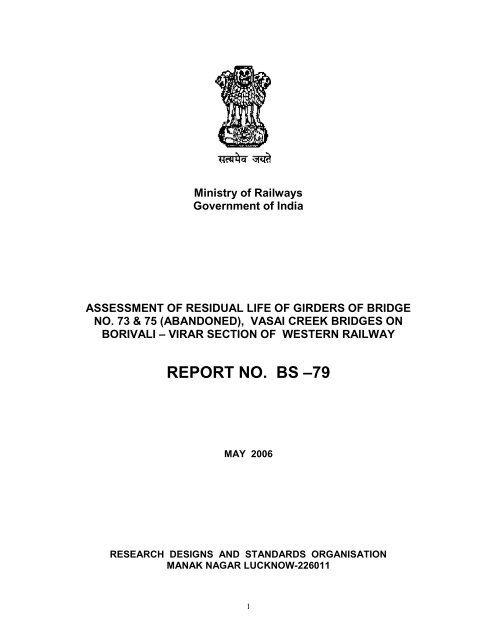
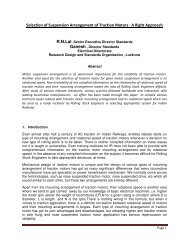

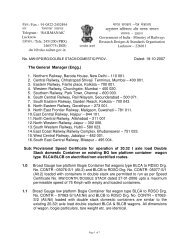
![Hkkjrljdkj] jsy ea= ky; vuql a/ kkuvfHkdYivkSj ekudlax Bu y ... - rdso](https://img.yumpu.com/21978459/1/184x260/hkkjrljdkj-jsy-ea-ky-vuql-a-kkuvfhkdyivksj-ekudlax-bu-y-rdso.jpg?quality=85)

